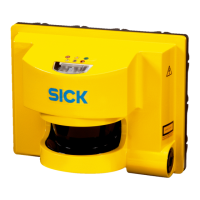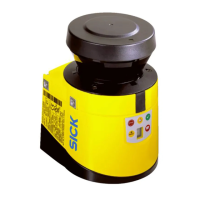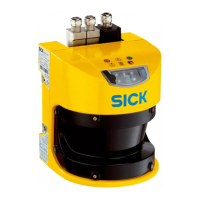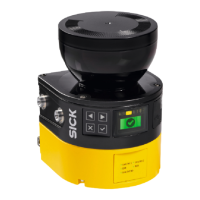4.3.9.2 Calculation example for the minimum distance
Calculation example of the minimum distance S according to ISO 13855
T
he example shows the calculation of the minimum distance for an orthogonal
approach to the protective field. A different calculation may be required, depending
on the application and the ambient conditions (e.g. for a protective field parallel to or at
any angle to the direction of approach or an indirect approach).
S = 1,600mm/s × T +850mm
where:
•
S =minimum distance in millimeters (mm)
•
T = stopping/run-down time for the entire system in seconds (s)
(Response time of the safety laser scanner + machine’s stopping/run-down time,
inc
l. response time of the machine’s control system and signal propagation time)
The approach speed is already included in the formula.
4.3.10 Mobile hazardous area protection
The safety laser scanner is mounted with a horizontal scan plane in a mobile applica‐
t
ion, like on an automated guided vehicle. In mobile hazardous area protection, the
safety laser scanner protects the hazardous area created by the vehicle’s movement.
The safety laser scanner detects a person’s legs. The protective field is parallel to the
direction of approach.
Figure 21: Mobile application in horizontal operation for hazardous area protection
NOTE
•
In a mobile applic
ation, a resolution of 70mm (leg detection) is sufficient for
detecting people. By contrast with stationary hazardous point protection, this is
also true for a low mounting height, as the safety laser scanner moves together
with the vehicle.
•
In the following calculation examples, only the vehicle speed is taken into account,
not the speed of a walking person. This is based on the assumption that the
person recognizes the danger and stands still.
4 P
ROJECT PLANNING
34
O P E R A T I N G I N S T R U C T I O N S | nanoScan3 – EtherNet/IP™ 8027909/2023-02-22 | SICK
Subject to change without notice

